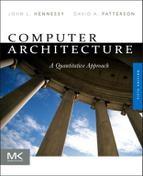W
WANs See Wide area networks (WANs)
WAR See Write after read (WAR)
Warehouse-scale computers (WSCs)
Amazon Web Services, 456–461
basic concept, 432
characteristics, 8
cloud computing, 455–461
cloud computing providers, 471–472
as computer class, 5
computer cluster forerunners, 435–436
cost-performance, 472–473
definition, 345
and ECC memory, 473–474
efficiency measurement, 450–452
facility capital costs, 472
Flash memory, 474–475
Google
containers, 464–465
cooling and power, 465–468
monitoring and repairing, 469–470
PUE, 468
server, 467
servers, 468–469
MapReduce, 437–438
network as bottleneck, 461
physical infrastructure and costs, 446–450
power modes, 472
programming models and workloads, 436–441
query response-time curve, 482
relaxed consistency, 439
resource allocation, 478–479
server energy efficiency, 462–464
vs. servers, 432–434
SPECPower benchmarks, 463
TCO case study, 476–478
WAW See Write after write (WAW)
Way prediction, cache optimization, 81–82
Way selection, 82
WB See Write-back cycle (WB)
WCET See Worst-case execution time (WCET)
Weak ordering, relaxed consistency models, 395
Weak scaling, Amdahl’s law and parallel computers, 406–407
Web index search, shared-memory workloads, 369
Windows operating systems See Microsoft Windows
Within instruction exceptions
definition, C-45
instruction set complications, C-50
stopping/restarting execution, C-46
Word count, definition, B-53
Word offset, MIPS, C-32
Words
aligned/misaligned addresses, A-8
AMD Opteron data cache, B-15
memory address interpretation, A-7 to A-8
MIPS data transfers, A-34
MIPS data types, A-34
operand sizes/types, 12
as operand type, A-13 to A-14
Workloads
execution time, 37
Google search, 439
Java and PARSEC without SMT, 403–404
symmetric shared-memory multiprocessor performance, 367–374, I-21 to I-26
WSC goals/requirements, 433
WSC resource allocation case study, 478–479
WSCs, 436–441
Write after read (WAR)
dynamic scheduling with Tomasulo’s algorithm, 170–171
hazards and forwarding, C-55
ILP limitation studies, 220
register renaming vs. ROB, 208
ROB, 192
Tomasulo’s advantages, 177–178
Tomasulo’s algorithm, 182–183
Write after write (WAW)
dynamic scheduling with Tomasulo’s algorithm, 170–171
execution sequences, C-80
hazards and forwarding, C-55 to C-58
ILP limitation studies, 220
microarchitectural techniques case study, 253
MIPS FP pipeline performance, C-60 to C-61
register renaming vs. ROB, 208
ROB, 192
Tomasulo’s advantages, 177–178
Write-back cache
coherence maintenance, 381
coherency, 359
definition, B-11
Flash memory, 474
FP register file, C-56
memory hierarchy basics, 75
Write-back cycle (WB)
basic MIPS pipeline, C-36
data hazard stall minimization, C-17
execution sequences, C-80
hazards and forwarding, C-55 to C-56
MIPS exceptions, C-49
MIPS pipeline, C-52
MIPS pipeline control, C-39
MIPS scoreboarding, C-74
pipeline branch issues, C-40
simple MIPS implementation, C-33
simple RISC implementation, C-6
Write broadcast protocol, definition, 356
Write buffer
AMD Opteron data cache, B-14
invalidate protocol, 356
memory consistency, 393
memory hierarchy basics, 75
write merging example, 88
write strategy, B-11
Write hit
cache coherence, 358
directory-based coherence, 424
single-chip multicore multiprocessor, 414
snooping coherence, 359
write process, B-11
Write invalidate protocol
directory-based cache coherence protocol example, 382–383
implementation, 356–357
snooping coherence, 355–356
Write miss
definition, 385
example calculation, B-12
locks via coherence, 390
memory hierarchy basics, 76–77
memory stall clock cycles, B-4
snooping cache coherence, 365
write process, B-11 to B-12
write speed calculations, 393
Write result stage
data hazards, 154
dynamic scheduling, 174–175
hardware-based speculation, 192
instruction steps, 175
ROB instruction, 186
status table examples, C-77
Write serialization
hardware primitives, 387
multiprocessor cache coherency, 353
snooping coherence, 356
Write stall, definition, B-11
Write-through cache
average memory access time, B-16
coherency, 352
invalidate protocol, 356
memory hierarchy basics, 74–75
miss penalties, B-32
optimization, B-35
snooping coherence, 359
write process, B-11 to B-12
Write update protocol, definition, 356
WSCs See Warehouse-scale computers (WSCs)
..................Content has been hidden....................
You can't read the all page of ebook, please click here login for view all page.
